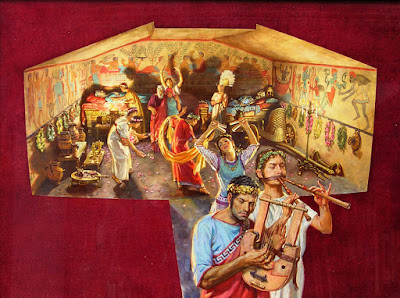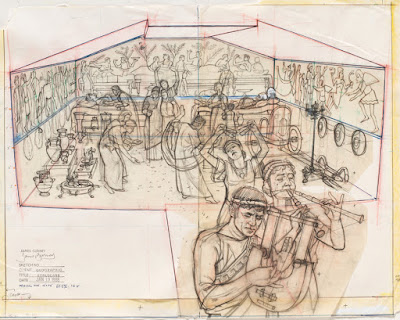
My painting takes us back to around 700BC to show a family departing the tomb, accompanied by musicians and dancers.



(Link to YouTube video) Starting with transparent watercolor and finishing with a few touches of opaque gouache, I paint a farm road. The gravel road is lined with bare trees, vines, and grassy fields.
To tell the story of traveling back in space, I include my bike parked against a rustic fence and a family walking along the road.
Art supplies listed in description below YouTube videoPainting a goat and sheep in the barn as a draft horse looks on.
 6. Drawing and Painting Animals by Fritz Henning
6. Drawing and Painting Animals by Fritz Henning In this YouTube interview, I chat with veteran art teachers Marshall Vandruff and Stan Prokopenko, founder of the online tutorial source Proko.com.
We talk about strategies for learning to draw and paint, both for students enrolled in art school and and people doing it on their own.
Here are some Amazon links to books that we mention.
Emile Chartier said of Balzac: "His genius consists in taking the commonplace as his subject and making it sublime without changing it."
Thanks Joe Paquet
Before Freud and Jung acknowledged the importance of the unconscious mind, dream images in the western world were mostly regarded through the filter of Christianity.
According to Jean-Claude Schmitt, "The medieval conception of dreams differs significantly from ours: dreaming was not the psychic activity of an individual, but his immediate getting in contact with the powers of the beyond, either positive or negative, during his sleep. Hence the distinction between 'true' dreams (of divine origin) and 'false' dreams (diabolic illusions) and the systematic suspicion towards dreams. (Source)"

Visual form agnosia is the inability to recognize familiar objects. The problem isn't just being able to name something that you see; it's understanding the meaning of them, recognizing what they are.
Roses from my video Flower Painting in the Wild
A person with such a condition might look at a bunch of roses and say it's "a cluster of convoluted pink forms held up by vertical green attachments."
People with visual form agnosia typically have otherwise normal eyesight, intelligence, memory, attention, and language ability.
Scientists have studied patients with this condition, often caused by a brain injury. These studies have yielded insight about the localization of functions in the brain and the pathways followed by neural activity as images are decoded. Recognition of objects seems to happen in the sides of the brain, not along the top of the brain.
That led me to wonder if there's a resemblance between visual form agnosia and the particular mode an artist shifts into while doing a painting. That is, don't we have to shut off the "naming engine" or the "categorization machine" in order to really see what we're painting?
Perhaps one day scientists will study what happens in an artist's brain at various stages of the process of drawing and painting.
Scientists at Purdue University have developed a white pigment that they say is significantly whiter than existing pigments. A surface looks white because it reflects back a diffuse version of most of the the light hitting it.
This new pigment reflects back up to 98% of the sunlight, while commercially available white pigments only reflect back between 80 and 90 percent.

"The new paint contains a compound called barium sulfate, which is also used to make photo paper and cosmetics. 'We used a very high concentration of the compound particles,' explained Prof Ruan. 'And we use lots of different sizes of particles, because sunlight has different colours at the different wavelength.' How much each particle scatters light depends on its size, 'so we deliberately used different particle sizes to scatter each wavelength.'"
Then the pandemic lockdown happened.
When the date was set for the staff to exit the building, she knew she might not be able to visit it again. So while she still had access, she had a brainstorm: why not document the show with a curator's tour?

Our boat brought us to a settlement of crested hadrosaurs and their human assistants, where we spent a few days drying out in the smoky attics of their houses"
The painting is done in oil wash over pencil on illustration board, which has been sealed first with some workable fixative spray and then with a thin layer of acrylic matte medium.

Illustrations from Dinotopia: A Land Apart from Time.
Read more about colexification in Science Magazine
Suppose an art director looked at one of your pieces and said "Great, but could you make it more goth?"
You'd know what to do, right? How about taking a cat picture and making it more cute or changing a tiger into a lion?
Computers, using large data sets, can accomplish such manipulations. In the top row of each pair is the input image. Below that is the manipulation. The phrase is the text prompt used to drive the manipulation.Eugen Dücker 1841-1916 painted this portrait—possibly a self portrait—in 1900, showing a portable lap box rig used frequently by plein-air painters at the time.
For a long time, scientists believed that images were decoded in a bottom-up process.
It was thought that the image arrived on the retina and was sorted out in stages, starting with edges and shapes that were then assembled into recognizable objects, faces, or symbols by specialized areas of the brain.
You may recognize what this image represents just from the top of the picture; you may even guess who painted it.